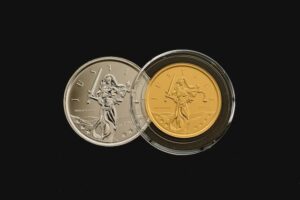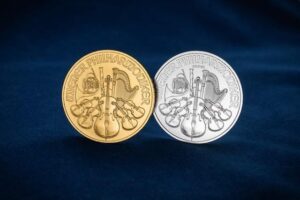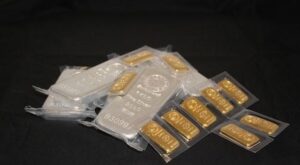Investing involves risk. The sort of volatility and risk depends on the asset. For instance, stocks have the potential for growing rapidly but correlate with the market and the economy making them vulnerable to downturns.
Contrastly, physical commodities such as precious metals, like gold and silver, don’t correlate in the same way with the market; they actually act as a hedge against the threat of the economy spiraling and potential losses. The metals, however, don’t offer exceptional growth.
Instead, investors need to depend on the value increasing. That has the potential to happen in cases of inflation or a poor economy, a reason many clients choose to add the option as an opposing element to their paper assets, hoping the two will create a balancing effect within a healthy investment portfolio.
To establish yourself as a savvy investor, you’ll need to become familiar with the assets you choose to maintain a strong strategy worthy of financial success. What should you know about gold and silver that you might not be aware of? Consider these facts before committing to an investment.

What Do Savvy Investors Understand About Gold And Silver Investing
To invest wisely, a shrewd investor will educate on the assets, considering how the different classes impact each other. For instance, will there be an impact on paper assets like stock holdings if a portion of investment funds go toward gold and silver?
In fact, these are contrasting asset classes that correlate uniquely with the markets. The precious metals boast of being protection for investment wealth. That means as the stocks build it, gold and silver preserve it.
The physical commodities don’t grow as rapidly. Still, they hold steady, referred to as a “store of value,” and can rise in value when there’s uncertainty within the market, speaking more about gold in that respect.
Before committing to these as a “safe haven” investment, consider a few facts to make a more informed decision.

● Precious metal firms present specific metals for holding in IRAs
A precious metals company will display specific gold, silver, platinum, and palladium metals deemed IRA-eligible by the Internal Revenue Code for investors to purchase. These are held in a special retirement account called a self-directed IRA set aside for unconventional assets like precious metals.
While many of the guidelines associated with the self-directed accounts mimic the conventional IRAs, the IRS oversees many regulations with gold and silver IRAs making these more complex than a standard individual retirement account.
That includes the types and forms of metal that can be held, purity and weight, designated coins that are not deemed rare or collectible, and where the precious metals must be stored.
● Gold and silver don’t provide steady gains
Paper assets offer investors relatively steady gains. For an example, an investor can quite often anticipate quarterly dividends with stocks. In a similar vein, investors who have Exchange-traded Funds (ETFs) and mutual funds might expect capital gain or dividend distributions throughout the years.
Plus, those who have bonds will usually receive interest. All these various payments are added to possible “price appreciation” on the individual assets.
Contrastly, physical precious metals won’t pay interest or dividends. You, as the investor, will only see gains with these assets if the product rises in value and you can sell it for a greater amount than you paid.
● Silver might have the edge over gold on some counts
Silver’s price is exceptionally more volatile than that of gold regularly. It’s suggested that when you wager accurately on how the price point might sway, a short-term trader could use the volatility to their advantage. However, looking at the metal from a diversifying perspective, it falls more in the negative category.
Gold’s price point remains relatively steady and acts as almost a stabilizing asset for an investment portfolio. Silver is more correlated than gold to the “broad” economy because of its extensive industrial uses, while gold has fewer purposes. With minimal correlation, gold acts as a safe haven in a paper-heavy portfolio.
Gold is much more expensive than silver. For instance (quote), “The spot price in January of 2022 for one ounce of gold was $1821.86 compared to the spot price for one ounce of silver at $23.16.” This is the amount an investor can buy the metals at any given time on the open market.
Price points tend to vary with time and conditions of the economy and based on the market, but there is no denying the substantial discrepancy.

● Physical precious metals for purchase come with stipulations
When buying physical precious metals, an investor usually does so to hold the metal in an IRA for retirement. In doing so, the metal must come in bullion, bars, coins, or rounds.
The IRS code indicates specific types and forms of precious metals that can be held in an IRA based on fineness, purity, and weight and designates specific coins that do not include rare or collectibles. The metals must be purchased through a precious metal broker specializing in the products.
Once a transaction has been made, a primary consideration is determining where you will place the gold or silver for storage. When held in an IRA, the custodial service will hold the metal in an IRS-approved, insured depository of your choosing.
You’ll want to research the facility to learn how it will safeguard your assets. Storing precious metals held in an IRA in your home will result in tax consequences and penalties.
Final Thought
An investment in alternative assets like precious metals can potentially safeguard a “paper-” heavy portfolio. Still, many variables come into play regarding whether the metal you choose suits your objectives. Go here for details on how much gold and silver you should commit to.
A priority is educating on gold and silver, especially if you’re new to alternative assets. Once you thoroughly understand how precious metals work, you’ll be better prepared to commit to an investment that directly aligns with your financial agenda.
